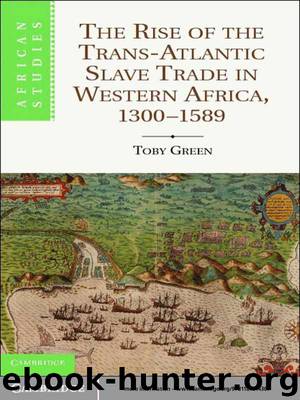The Rise of the Trans-Atlantic Slave Trade in Western Africa, 1300-1589 (African Studies) by Dr Toby Green

Author:Dr Toby Green [Green, Toby]
Language: eng
Format: epub
ISBN: 9781107634718
Amazon: 1107634717
Publisher: Cambridge University Press
Published: 2014-03-20T00:00:00+00:00
Elites, Slavery and the Boundaries of Creolisation in Western Africa
If renegade New Christians were increasingly inclined to settle in Upper Guinea in an attempt to seek a certain amount of freedom and enhance their trading activities, their increased settlement must also have meant there was a growing willingness among some Upper Guineans to accept them. Yet although the case studies have indeed shown that there was an alliance between Kassanké and New Christians in the mid-sixteenth century, they have told us little about how this alliance was formed in the first place. Moreover, given the inevitable Eurocentric nature of these written sources, and although we have learnt much about New Christian patterns of settlement among the Kassanké, we have learnt much less as to why they were accommodated by Kassanké lineage heads.
Understanding how Kassanké elites and New Christian lançados came to forge this alliance is, however, vital if we are to grasp how Atlantic Creole cultures became consolidated in Upper Guinea as well as in Cabo Verde. In order for this to occur, it was not just sufficient for traders to ply back and forth between Cabo Verde and Bugendo. There had to be reasons for them to be accepted among the Kassanké, and cultural practices in West Africa themselves had to change. Thus in order to understand how this occurred we need to grasp how the alliance was formed in the first place, for this will show how deep-seated the changes were and which elements of Upper Guinean societies were affected.
Useful comparisons can be made here to other known events. It may help, for instance, to draw an analogy with the most famous lançado of the sixteenth century, known as Ganagoga, meaning “the man who speaks all the languages” in the Biafada language.92 Ganagoga’s Portuguese name was João Ferreira, and according to Almada he was a New Christian.93 Almada describes how the lineage head (Duque) of the Gambia River port of Casão had asked Ganagoga/Ferreira to go to the court of the Pullo king of Fuuta Tooro on the banks of the Senegal River, and that once he was there he married the king’s daughter and had a child with her.94 Ganagoga was apparently an influential figure among the Pullo aristocracy. The English sailor Reynolds stated of the area of the River Senegal that there “no Spaniard or Portugueze use to trade; and only one Portugueze, called Ganigoga, dwelleth far within the River, who was married to a king’s daughter”.95
The way in which Ganagoga/Ferreira forged an alliance through marriage into the Pullo aristocracy is instructive as to how the Kassanké–New Christian alliance may have developed. This lançado was on good terms with the lineage head of Casão and spoke many languages, so clearly he was well versed in the customs of Upper Guinea. Most likely, his behaviour in Fuuta Tooro replicated a strategy that had already found success in Casamance and on the Gambia. Moreover, association by New Christians with ruling circles followed the pattern their ancestors had known
Download
This site does not store any files on its server. We only index and link to content provided by other sites. Please contact the content providers to delete copyright contents if any and email us, we'll remove relevant links or contents immediately.
| Africa | Americas |
| Arctic & Antarctica | Asia |
| Australia & Oceania | Europe |
| Middle East | Russia |
| United States | World |
| Ancient Civilizations | Military |
| Historical Study & Educational Resources |
Goodbye Paradise(3464)
Men at Arms by Terry Pratchett(2686)
Tobruk by Peter Fitzsimons(2380)
Arabs by Eugene Rogan(2198)
Pirate Alley by Terry McKnight(2132)
Borders by unknow(2122)
Belonging by Unknown(1737)
It's Our Turn to Eat by Michela Wrong(1596)
The Biafra Story by Frederick Forsyth(1566)
Botswana--Culture Smart! by Michael Main(1488)
The Source by James A. Michener(1462)
A Winter in Arabia by Freya Stark(1450)
Gandhi by Ramachandra Guha(1437)
Coffee: From Bean to Barista by Robert W. Thurston(1423)
Livingstone by Tim Jeal(1396)
The Falls by Unknown(1374)
The Shield and The Sword by Ernle Bradford(1316)
Africa: Altered States, Ordinary Miracles by Richard Dowden(1297)
Egyptian Mythology A Fascinating Guide to Understanding the Gods, Goddesses, Monsters, and Mortals (Greek Mythology - Norse Mythology - Egyptian Mythology) by Matt Clayton(1280)
